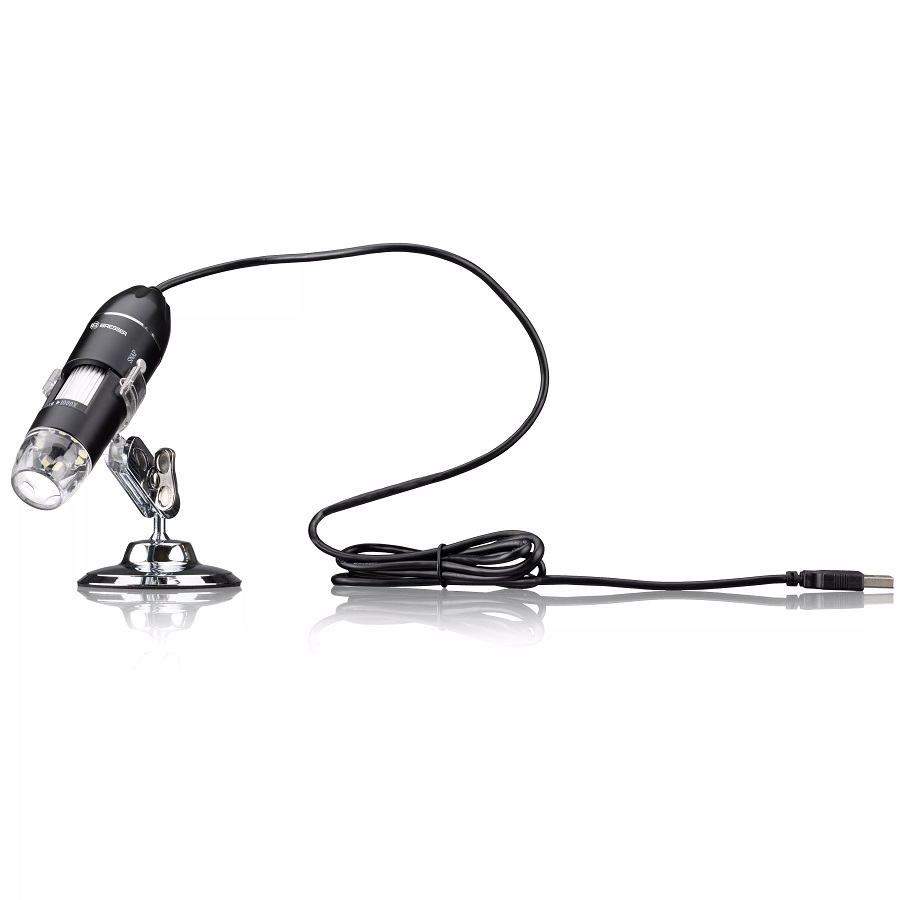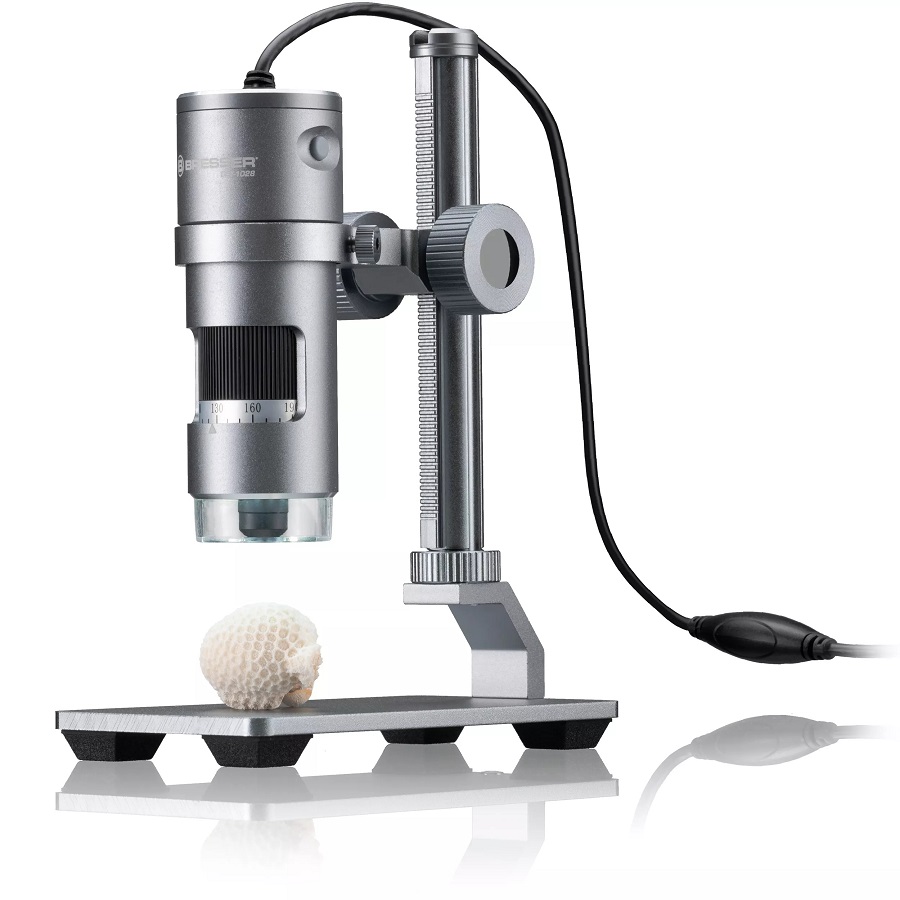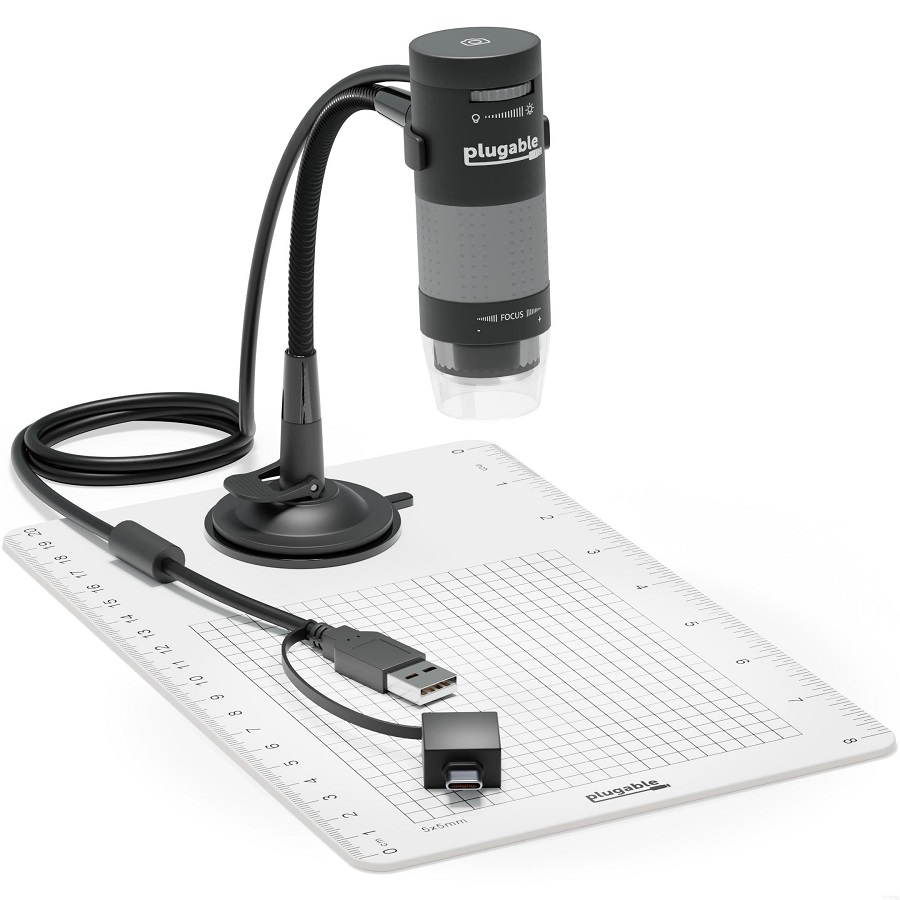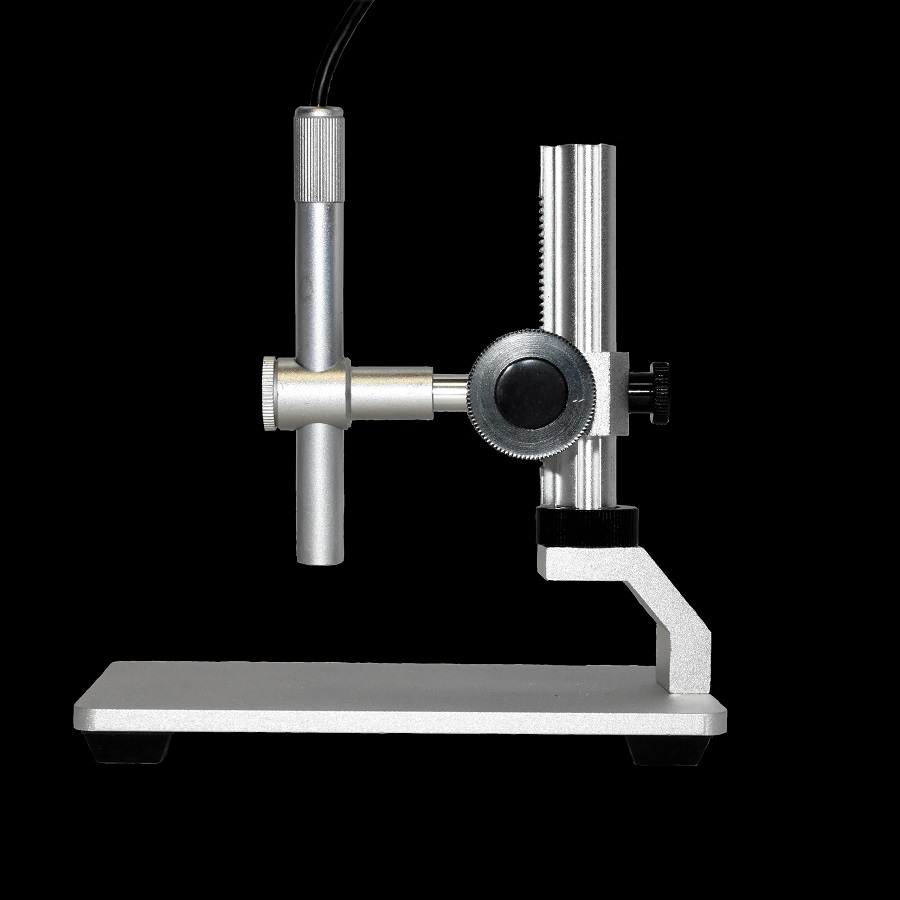What is a USB Microscope?
A USB microscope is a digital device. It connects to a computer through a USB port. It has a camera that captures images and videos of tiny objects. This microscope is compact and user-friendly, differing from traditional models. Users can see the magnified view on their computer screen. They can also save images for later use.
USB microscopes are versatile tools. They suit various users, from students to professionals. Its applications range from education to scientific research. Because of its digital nature, it can integrate with software for more functionalities. This includes image analysis and sharing capabilities.
The portability of a USB microscope makes it ideal for fieldwork. Its plug-and-play setup means quick usage on almost any computer. This kind of microscope usually offers various magnification levels. This allows for study of objects at different scales.
To sum up, a USB microscope is a modern tool for magnification. It offers simplicity and versatility for various applications. It is a valuable asset in both educational and professional settings.

Key Features to Consider When Buying a USB Microscope
When in the market for a USB microscope, it can be quite challenging to choose the right one, given the variety available. Here are a few key features to consider to ensure you get a microscope that meets your needs:
- Magnification Level: Identify the magnification power you require for your tasks. USB microscopes offer a range of magnifications, typically from 20x to 2000x.
- Resolution: The clarity of the image is critical. Look for a USB microscope with a high resolution to provide crisp, detailed images.
- Image and Video Quality: Consider whether the microscope can capture images and videos, and the quality of these media. Higher megapixel cameras usually offer better quality.
- Compatibility: Ensure that the microscope is compatible with your operating system. Some may work with various platforms while others may not.
- Software Features: Check the software provided or supported by the microscope. Useful software features could include image analysis, measurement tools, and easy file sharing.
- Portability: If you need to use the microscope in different locations, portability becomes crucial. A lightweight and compact design will be beneficial.
- Illumination: Good quality lighting is essential for clear visibility. LED lights are commonly used because they offer bright, white light and have a long lifespan.
- Build Quality: A durable build is important, especially if you will be using the microscope frequently or in the field.
- Accessories: Some microscopes come with additional accessories such as carrying cases, stands, or specimen slides. These can be very handy.
- Price: Set a budget and find the best USB microscope within it. However, don’t compromise essential features for cost savings.
Incorporating these considerations will help you find a usb microscope that fits your specific needs, whether for educational purposes, hobbies, or professional use. Remember that the best USB microscope for you depends on how you plan to use it. Make an informed decision by carefully assessing each feature in line with your requirements.
Top Uses for USB Microscopes in Various Fields
USB microscopes serve many users across diverse fields. Their popularity is rising due to flexibility and digital features. Here are the top applications of USB microscopes:
- Education: Teachers use them to spark student interest in science. With a usb microscope, live images can be projected for the class. This interactive method enhances learning.
- Laboratory Research: Researchers rely on them for detailed analysis of specimens. They capture high-resolution images for study and documentation.
- Electronics: Technicians examine circuit boards and components. It aids in checking soldering quality and diagnosing issues on tiny electronic parts.
- Jewelry Making: Jewelers inspect gems and settings with precision. It helps them appraise and craft intricate jewelry designs.
- Collectibles: Hobbyists view stamps, coins, and other collectibles. They can see details that are invisible to the naked eye.
- Medical Diagnosis: Doctors use them to analyze skin conditions. They see surface details to diagnose or follow up on treatments.
- Forensics: Forensic experts examine evidence at a microscopic level. They can uncover clues that are essential in solving crimes.
- Printing: They check print quality, including color and registration. It allows for adjustments to be made to achieve perfect prints.
By encompassing a usb microscope into these fields, professionals enhance their work’s accuracy. The tool aids users to see beyond what the eye can observe. It’s important to note that each use case may require specific features from the microscope. For example, high magnification is essential for biological research, while resolution is key for quality inspections.
These practical uses show the versatility of USB microscopes. Whether for education, professional analysis, or leisure activities, this tool offers benefits to all. It’s a testament to how technology can transform traditional methods in various fields.

How to Set Up and Use Your USB Microscope
Setting up a USB microscope is straightforward. First, ensure your computer’s operating system is compatible with the microscope. Then, follow these simple steps:
- Installation of Software: Begin by installing any necessary software or drivers that come with the microscope. This software is critical for functionality.
- Connecting to the Computer: Use the USB cable to connect the microscope to your computer’s USB port.
- Adjusting the Microscope Stand: Position the stand so the microscope is stable and focused on the object you wish to examine.
- Turning On the Illumination: If your microscope has built-in LED lights, turn them on for clear visibility of the specimen.
- Calibrating the Magnification: Start with lower magnification to locate your subject, then gradually increase it as needed.
- Focusing the Image: Use the focus wheel to sharpen the image until you get a clear view on your screen.
- Capturing Images or Videos: Utilize the software to capture and save images or record videos of your observations.
- Adjusting Settings: Play with the software settings. You can typically adjust brightness, contrast, and resolution for the best image quality.
- Analyzing and Sharing: With the right software, you can analyze the images and share them with colleagues or classmates.
Remember, before using your USB microscope, check the manual for specific instructions. Different models might have unique features or steps for usage. With these points in mind, you’ll be ready to explore the world on a microscopic level with ease.
Understanding Magnification and Resolution in USB Microscopes
When choosing a usb microscope, magnification and resolution are key factors. These two aspects greatly impact the quality of the images you’ll see. Understanding their role is crucial for selecting the right equipment.
Magnification: This refers to how much larger the microscope can make an object appear. USB microscopes often have a wide range of magnification levels, from 20x to 2000x. You need to match the magnification to your requirements. A higher magnification allows you to see finer details, but the field of view will be smaller.
For educational use, a lower magnification might be sufficient. It allows for a broader view. Professional tasks, such as electronics repair or laboratory work, may require higher magnifications.
Resolution: This determines the clarity of the magnified image. It’s about the number of pixels in the digital image captured by the microscope’s camera. A higher resolution means more pixels, which leads to clearer, more detailed images. When assessing resolution, look for a usb microscope with a high megapixel camera.
The resolution can be more important than magnification in some cases. For example, if you need to capture detailed images for documentation, resolution plays a pivotal role.
In summary, higher magnification is not always better. The right balance between magnification and resolution depends on how you plan to use your usb microscope. For most users, a combination of moderate magnification and high resolution offers the best versatility. It ensures quality images without losing too much of the context of the viewing area.

Software and Compatibility: Getting the Most Out of Your USB Microscope
When it comes to maximizing the potential of your usb microscope, software and compatibility are pivotal. Without the proper software, you might miss out on advanced features that enhance your viewing experience. Compatibility ensures that your microscope functions seamlessly with your computer system. Here’s what to look for to ensure you get the most out of your device:
- Compatible Operating Systems: Confirm that the microscope’s software works with your computer’s OS. Whether you’re using Windows, macOS, or Linux systems, compatibility is key.
- Software Functionality: Seek software that offers comprehensive features. Look for capabilities like image analysis, measurement options, and file exporting.
- User-Friendly Interface: Select software with an intuitive design. It should be easy to navigate for users of all experience levels.
- Regular Updates: Choose a product supported by regular software updates. This ensures ongoing improvements and security fixes.
- Driver Support: Make sure that your microscope comes with the necessary drivers for installation. This step is often crucial for the initial setup.
- Third-Party Software: Sometimes, third-party software can enhance functionality. Research compatible programs that could offer additional benefits.
By prioritizing software that is feature-rich and compatible with your system, you unlock the full potential of your usb microscope. It not only simplifies the process of capturing and analyzing images but also provides a more enjoyable and productive user experience.
Maintenance and Care Tips for USB Microscopes
Proper maintenance and care are crucial for the longevity of your USB microscope. Here are essential tips to ensure optimal performance:
- Gentle Handling: Always handle the microscope with care. Avoid harsh movements that can damage precision components.
- Regular Cleaning: Dust and fingerprints can affect image quality. Use a soft, lint-free cloth to wipe the lens gently.
- Avoid Moisture: Keep the device dry. Moisture can harm the electronic parts and lens of the microscope.
- Cable Management: Prevent damage to the USB connection by avoiding tight bends in the cable.
- Safe Storage: Store your microscope in a safe place, away from direct sunlight and extreme temperatures.
- Software Updates: Keep software up to date. Updates often fix bugs and improve features.
- Inspect Regularly: Check for loose parts or damage. Attend to repairs promptly to avoid worse issues.
- Battery Care: If your microscope is battery-operated, ensure batteries are charged and stored properly.
- Follow the Manual: Refer to the user manual for specific maintenance guidance tailored to your model.
By following these simple yet effective tips, you can maintain the quality and extend the life of your USB microscope. Regular maintenance will keep your device ready for when you need it, ensuring reliable and clear magnification for all your observation needs.
A Look at the Best USB Microscopes on the Market
Choosing the best USB microscope can be a tough decision with so many options available. To ease your search, we’ve compiled a list of top-performing microscopes on the market. These picks stand out due to their quality, features, and user reviews.
- The High-Resolution Expert: This usb microscope boasts a high megapixel camera. It offers crystal-clear images making it perfect for professionals who need detailed analysis.
- The Beginner-Friendly Model: Ideal for new users, this microscope provides easy operation. It comes with a user-friendly software interface and basic magnification suitable for educational purposes.
- The Portable Prodigy: With its lightweight design, this usb microscope is great for fieldwork. It doesn’t sacrifice quality for mobility and includes a durable build for outdoor use.
- The All-Rounder: This microscope strikes a balance between magnification and resolution. It is versatile enough to handle a variety of tasks from jewelry inspection to electronics repair.
- The Budget Pick: For those who watch their wallet, this model offers decent performance at a lower cost. It includes essential features like LED illumination and easy compatibility with multiple systems.
- The Tech-Savvy Choice: This usb microscope integrates the latest software features. It supports advanced image analysis and has extensive device compatibility, appealing to tech enthusiasts.
Each of these USB microscopes has its own advantages. Your choice should align with your specific needs, whether for study, work, or hobby. Keep key factors like magnification, resolution, software, and compatibility in mind when making your decision. Remember, the best USB microscope for you is one that fits your requirements and budget. When you choose the right model, you unlock a world of microscopic discoveries.
